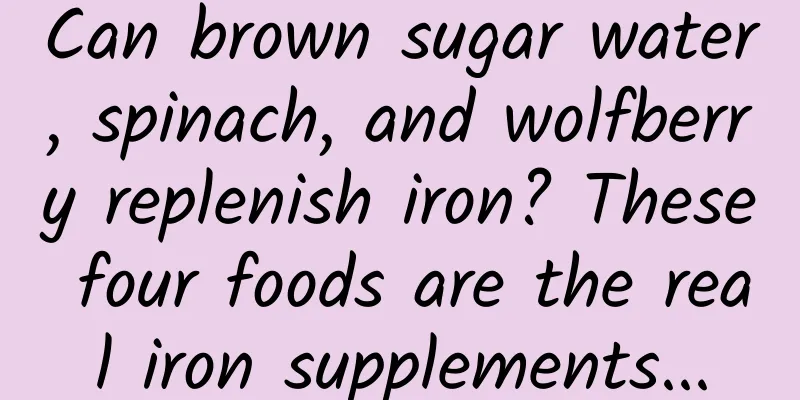Why do we need to blanch the ingredients? What are the tips for blanching?

|
Whether you are a master chef with superb cooking skills or a novice who is new to the kitchen, most of them know how to blanch. Although the blanching operation seems to be the same, the principles and purposes behind it are different. GIF source: SOOGIF Whether the blanching process is done properly will directly affect the quality of the finished dish. But it doesn’t matter! Dad Review has compiled a summary chart for you to help you quickly get the blanching skills: Next, let’s talk about the reasons for blanching different ingredients separately to help you deepen your understanding. 1. Cold water blanching ----- Remove odor/fishy smell Objects: pork, beef, mutton, etc. Blanching method: Put in cold water and remove after it is completely cooked. Generally speaking, pork, beef, mutton, etc. will be blanched before stewing or stir-frying. GIF source: SOOGIF Meat is usually blanched in cold water in order to remove the "blood" from the meat. This "blood water" is not real blood. Its main substances are myoglobin, a small amount of oil and some impurities. Some fishy substances are dissolved in the oil. As the water temperature rises during the heating process, the oil slowly dissolves and myoglobin acts as a surfactant to produce foam. These foams carry oil, water vapor, and air, eventually forming froth. If hot water is put into the pot, the protein on the outer layer of the meat will quickly denature and shrink the moment it is put into the pot, resulting in the inability to dissolve the "blood" inside, and the fishy smell removal effect will not be achieved. Blanching can also reduce the foam on the meat after cooking, making the soup clearer and more transparent, improving the appearance of the dish. We conducted an experiment and measured the purine content of fresh hot pot soup base and the soup base after eating hot pot meat. We found that the purine content in the soup base after eating hot pot meat increased significantly. As a side note, blanching can dissolve some of the purine in the meat and reduce the purine content to a certain extent. If your uric acid level is slightly high, you may try blanching the meat before cooking. However, the purine-lowering effect of blanching is limited. If you are a gout patient or someone with high uric acid levels, you still need to control your diet. 2. Blanching in hot water - Maintaining color Objects: Cooking vegetables that are easy to change color, such as loofah, lotus root, etc. Blanching method: Put the vegetables in hot water until they change color. Some vegetables contain high levels of polyphenol oxidase (PPO), such as loofah and lotus root. They are prone to enzymatic browning during cooking, and if you are not careful, a car accident like this will occur... Image source: Internet There is also a car accident scene like this: Image source: Internet At this time, you need to use the magical "high temperature magic". GIF source: SOOGIF Polyphenol oxidase is unstable to heat, and high-temperature heating in a short period of time can inactivate and denature it, thereby blocking the occurrence of enzymatic browning and preventing the vegetables from turning black during subsequent cooking. Some people have done relevant experiments and found that blanching in 100℃ boiling water for more than 20 seconds can make most (more than 50%) of the polyphenol oxidase inactive. Because it takes very little time, it is also called "flying water". 3. Blanching in hot water - remove oxalic acid. Target: vegetables with high oxalic acid content, such as spinach, bamboo shoots, wild rice stem, etc. Blanching method: Blanch leafy vegetables until they change color. Bamboo shoots and wild rice stems require a little longer. Too much oxalic acid will affect the body's absorption of minerals such as calcium and zinc. They also enter the human kidneys and combine with calcium in the body to form calcium oxalate, which accumulates over a long period of time to form kidney stones. In addition, oxalic acid tastes sour and astringent, and if it is not removed, it will affect the taste. Oxalic acid is easily soluble in water. Studies have shown that 40%-70% of the oxalic acid in vegetables such as spinach and amaranth can be removed by blanching them in boiling water. At the same time, adding an appropriate amount of salt is also beneficial to the dissolution of oxalic acid. For blanching in this type of situation, time and water temperature/volume are very important. time The blanching time should not be too long, otherwise the vegetables will be boiled. Not only will it cause the color and taste of the cooked vegetables to be unpleasant, it may also cause the loss of many nutrients in the vegetables (such as vitamin C, potassium, and magnesium). Since vegetables vary in size, it is difficult to standardize the blanching time. Here is a simple trick: After the leafy vegetables are put into water, their color becomes slightly darker (usually in about 15 seconds), and then they can be taken out and set aside. Water temperature/water volume The water temperature cannot be too low, and the food can only be put into the pot when it is boiling. You can add some cooking oil in moderation to prevent oxidation due to contact with air. The amount of water should be enough to cover the vegetables, which can shorten the blanching time and prevent the taste and color from being affected by too long a time. When the time is up, take it out in time and drain the water to prevent the residual heat from continuing to heat it. If you need to blanch a lot of vegetables at one time, you can blanch those with less odor first, then those with stronger odor; blanch those with lighter color first, then those with darker color. GIF source: SOOGIF 4. Blanching in hot water - remove nitrite/nitrate Target: vegetables containing nitrite/nitrate, such as Chinese toon Blanching method: Boil in boiling water for more than 30 seconds There was once an old man who suffered from nitrite poisoning and multiple organ failure due to eating too much scrambled eggs with Chinese toon. For this type of vegetables containing nitrite/nitrate, you can blanch them in hot water before cooking. This can dissolve some of the nitrite and also reduce the activity of nitrate reductase. 5. Blanching in hot water - remove toxins Target: Vegetables that are poisonous when eaten raw, such as day lily, green beans, bracken, etc. Blanching method: Put in hot water and blanch until cooked. Many vegetables contain some water-soluble natural toxins or substances that may cause cancer. Blanching can partially remove these substances. Daylily Fresh daylily contains colchicine. This substance itself is non-toxic, but after being ingested by the human body, it will gradually oxidize into highly toxic colchicine in the intestines, causing symptoms such as nausea, vomiting, and diarrhea. Blanching can effectively remove the colchicine in it. French beans Green beans contain saponins and lectins. If they are not blanched and not completely cooked, they can cause nausea, vomiting, and numbness of the limbs. Therefore, it is best to pinch off the ends of the green beans before cooking, and blanch them in boiling water before cooking; you can also cook them directly, but make sure the green beans are thoroughly cooked. Bracken Bracken contains a certain amount of prototaxol. Although this substance is not a plant toxin, it is classified as a Class 3 carcinogen by the International Agency for Research on Cancer (IRAC) under the World Health Organization (there is no evidence yet, but it may be carcinogenic). Other substances listed as Class 3 carcinogens include Sudan Red I, diesel (light fraction), hair dye products (personal use), etc. Although the carcinogenicity of prototaxol is still uncertain, to be on the safe side, we still recommend blanching the bracken in boiling water before cooking and cooking it thoroughly. Soaking black fungus Wood ear itself is non-toxic, but it is very easy to breed bacteria and mold during the soaking process, and is more likely to produce toxins. We have tested the microbial content of our own soaked black fungus and the soaked black fungus sold in supermarkets, and the results are not optimistic. After a long soaking time, the total number of colonies directly "exploded": Therefore, it is enough to soak the fungus for 2 hours. If it exceeds this time, it is recommended to blanch it in water to kill the microorganisms on the surface. However, we would also like to remind you: High temperature can kill microorganisms, but it cannot completely destroy the toxins produced!!! If it's soaked for too long, even blanching it in water won't save it. So just do like the scumbag and throw it away. Image credit: SOOGIF Some friends blanch vegetables in one pot to save trouble. This is very inappropriate! After blanching these vegetables, the natural toxins are dissolved in the water. If you blanch another vegetable, they will easily contaminate each other. Therefore, it is best to change the water each time you blanch a vegetable. 6. Blanching in hot water - remove mud and sand Objects: Shellfish, such as white clams, flower clams, razor clams, etc. Blanching method: put the water into the pot until it opens This blanching method is mainly for shellfish. Blanching the shells in boiling water can open their mouths, and rinsing them with cold water can remove some of the mud and sand hidden in the gaps between the shells. You can enjoy spicy clams, scallion oil razor clams, and steamed eggs with clams without spitting out every bite. GIF source: SOOGIF It should be noted that this type of food cannot be blanched in cold water, otherwise the heating time will be too long and the meat of the seafood will become tough. 7. Blanching in hot water - peeling objects: tomatoes, small potatoes, etc. Blanching method: Put the hot water into the pot, cook for a suitable amount of time, then remove and rinse with cold water For those who have "kitchen obsessive-compulsive disorder", peeling some vegetables is a necessary prerequisite for the perfect presentation of a dish. For vegetables with too much juice like tomatoes, violent peeling will easily cause too much water loss, and the scene will be "bloody" at one point; for vegetables that are too small like potatoes, peeling is not easy to do, and if you are not careful, you will get injured gloriously. GIF source: SOOGIF Blanching is a perfect solution. The method of blanching in hot water and rinsing in cold water makes full use of the principle of thermal expansion and contraction to separate the skin and flesh of vegetables, making it easy to remove the vegetable skin. It won't damage the surface of the vegetables too much, nor will it waste too much time. Image credit: SOOGIF It is a must-have kitchen trick for lazy people~ Friendly reminder: To remove the odor, meat should not be put into boiling water. You can add some cooking wine, onion, ginger and garlic to remove the fishy smell; When blanching vegetables, make sure to add enough water (completely covering the vegetables). Add the vegetables after the water boils, and do not blanch them for too long. When blanching different vegetables, it is best to use a different pot of water for each vegetable. After blanching the vegetables, drain them in time to prevent them from continuing to be heated. Seafood ingredients cannot be blanched in cold water, otherwise the heating time will be too long and the meat will become tough. The above is the blanching tips compiled for you by Dad Review. It may seem complicated, but once you master the principles, you can apply them to other situations. You are only one practice away from becoming a kitchen veteran. I wish you all a happy cooking in advance~ GIF source: SOOGIF References: [1] Zhao Gongling, Liang Xinhong, Kong Jin. Effects of blanching on oxalic acid and vitamin C in spinach and amaranth[J]. Science and Technology of Food Industry, 2010, 000(001):367-368,401. [2] Liu Weijia, Zheng Donghui, Yan Xiaoxia, et al. Effects of soaking and blanching on oxalic acid and nitrate content in spinach[J]. Agricultural Machinery, 2012(09):134-137. [3] Du Deyu, Zhang Beibei, Lei Mianhua, Jiang Xiaoxuan, Tie Min. Effects of blanching on nitrite content and color of Toona sinensis[J]. Shaanxi Agricultural Sciences, 2019, 65(09): 53-59. [4] Bi Xiufang, Xie Ling, Liu Xiaocui, et al. Effect of Blanching Treatments on the Quality of Fresh-cut Root Vegetables%[J]. Journal of Xihua University (Natural Science Edition), 2019, 038(004):45-49. [5] List of carcinogens from the World Health Organization’s International Agency for Research on Cancer http://www.nmpa.gov.cn/WS04/CL2068/329742.html |
<<: I'm under a lot of pressure! Should I see a psychologist?
>>: What does agate mean and symbolize (different colors have different meanings and symbols)
Recommend
How to prevent tethered cord syndrome during pregnancy and childbirth
Pregnant women have to be very careful at all tim...
What should I do if I have frequent and urgent urination during pregnancy?
Pregnant women will encounter some very embarrass...
Fetal crown-hip diameter standard for males and females
After a woman becomes pregnant, many families are...
How to judge whether women are allergic to condoms
Condoms are a common contraceptive method with a ...
How to deal with postpartum urinary tract infection?
Women are prone to urinary tract infections after...
What is a salpingogram and how is it done?
Hysterosalpingography is generally used to detect...
What causes corpus luteum rupture?
Corpus luteum rupture may still be relatively unf...
When are women most likely to divorce?
Before marriage, women love to hear men say "...
What should I do if I have frequent fever during confinement?
If you have frequent fevers during the confinemen...
What are the symptoms after using the Xiaolu suppository?
Suppositories are external medications, so the si...
How many injections are needed for test tube
In vitro fertilization is a surgery that many fem...
【Health Lecture】Sleep well and you win
Sleep is an active process of the human body that...
Finger rubber band game
The novel coronavirus has disrupted our daily lif...
How to make steamed egg cake tender? Why does the steamed egg turn black?
Steamed egg custard is a good way to eat eggs. It...









